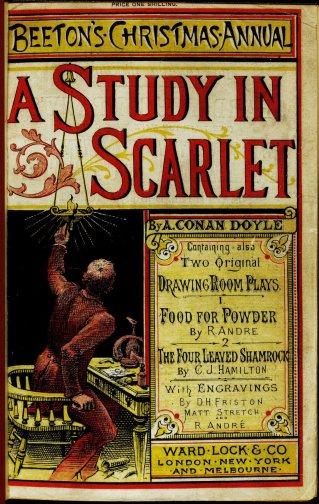
The fabulous thing about my shiny new Kindle is that books I’ve been meaning to read for years have suddenly become instantly available at just the moment I fancy reading them. I recently watched all of the back episodes of Sherlock (a fantastic series, if you haven’t seen it) and wanted to know how much correlation there was between the show and the stories. I wanted to start at the beginning and read A Study in Scarlet, and as soon as my new Kindle arrived, I hopped straight onto Amazon and downloaded the Complete Works of Sherlock Holmes for mere pennies. As soon as I clicked on the first page, I was hooked. The warmth and wit of Dr Watson’s narrative voice has that lovely gossipy, verbose quality that you only find in Victorian novels, but there is a freshness and an intimacy too that makes it feel surprisingly modern. I knew that I had found a new author to love.
When an American man is found dead in suspicious circumstances in an empty house, Inspector Gregson and Inspector Lestrade of Scotland Yard are stumped and come to Sherlock Holmes for help. The man has been identified as an Enoch Drebber, in London on business with his personal secretary Joseph Stangerson. There is no mark on his body, but there is blood on the floor, and the word ‘RACHE’ written on the wall. There seems to be very little to go on, but Sherlock, using his uncanny deduction skills, soon works out a profile of the murderer from his footprints, cigar ash and the height of the writing on the wall. Sherlock seems to be on the case, but then the Scotland Yard Inspectors announce they have arrested the criminal. However, within minutes of the arrest, Stangerson turns up dead too, and there is clearly no connection between the suspected criminal and this murder. As such, there is nothing left but for Holmes to work his magic, and the real criminal is quickly revealed in a dramatic turn of events.
The narrative then goes further back in time, to the pioneer days of mid 19th century America. We start with a dramatic scene of a lost man and a child waiting for death in a sunbaked valley of the Utah desert, supposedly on their way to a new life in the West. They are rescued from a certain demise by the arrival of a huge wagon train containing a certain Brigham Young and his disciples, who make them promise to join the Mormon church in exchange for shelter. These pioneers build Salt Lake City, and to all intents and purposes, their life appears to be prosperous and successful as their community develops over time. However, all is not harmonious. Those who dare to contradict the strict rules of the church fear for their lives. John Ferrier and his adopted daughter Lucy, the pair who were rescued from the desert, are two such unfortunates. Lucy’s desire to marry outside of the church will prove disastrous, and set up a feud that will be revenged twenty years later on the streets of London.
This is a fascinating story, that took me off in a direction I never expected. I had no idea half of Conan Doyle’s first Holmes novel was set in America, and I was also surprised that there was no facility provided for the reader to work out the murderer for themselves. Unlike modern day detective novels, there is no trail of clues left in the narrative. We cannot play armchair detective, but must wait for Holmes to reveal the story to us. In some ways, this can be frustrating, but it does also allow the reader to place themselves more accurately in the mind of Dr Watson, who is perpetually left in the dark thanks to Holmes’ eccentric and unfathomable methodologies. I was so intrigued and determined to find out the ending that I actually read the book in only two sittings, which is very rare for me. As one of (maybe the?) first examples of detective fiction, I think this is a must read for anyone interested in the development of the genre, and it has certainly given me a passion to read more. I am also now itching to revisit Agatha Christie, and I am wondering what other detective novelists from the 19th and early 20th century may have missed my attentions. I’m always spotting old green penguins in charity shops, but it’s hard to work out whether they’ll actually be any good, especially when many have such ridiculous titles (The Poisoned Chocolate Case, anyone?!). Does anyone have any recommendations?
